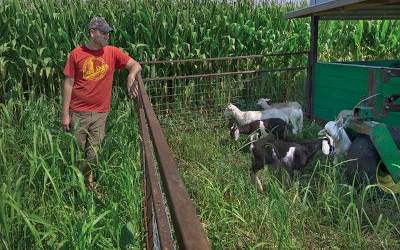Many Iowa farmers are considering adding livestock to their operations to boost their income potential. Zack Smith, a fifth- generation farmer near Buffalo Center in Winnebago County, is taking the livestock proposition a few steps farther.
Smith and his partners are experimenting with adding four species of livestock — sheep, goats, pigs and chickens — right into one of his northern Iowa fields.
Smith, working with Minnesota farmers Sheldon Stevermer and Lance Peterson, has developed a new agricultural production system called Stock Cropping. Stock Cropping is made possible with the design and construction of a mobile barn called the ClusterCluck 5000. They situated the wheeled barn in a field planted in alternating strips of 12 rows of corn and 20 feet of annual pasture. The farmers move the barn along the pasture strip twice a day, 11 feet at a time, using a winch system.
The idea behind the Stock Cropper, Smith said, is a creating a “biological hack” that can provide agronomic, economic and environmental advantages for farmers interested in increasing profitability and diversity on their farms. They wanted a system that is diverse, scalable and creates attributes that are in demand from consumers.
Planting annual pasture improves the soil and captures carbon. Grazing livestock provides manure to fertilize crops. And the Stock Cropper system is designed to raise high-quality, pasture-raised meat, which typically commands a higher price from consumers.
Finding advantages
“We are looking for ways to find an advantage in the market,” said Smith, a Winnebago County Farm Bureau member and a Pioneer seed dealer. “We aren’t interested in scaling acres as the answer to stay in business, so we want to find a different way to be profitable and add diversity to the northern Iowa landscape.”
Over the winter, Smith, Stevermer and Peterson used computer-aided design (CAD) to sketch out a movable livestock barn system.
The mobile barn houses the livestock as well as feed troughs and waterers. It provides the animals a constant supply of fresh pasture with a mix of species, including forage rape, cow peas, annual rye, oats and sudangrass, as well as room to move around and get fresh air.
The sheep and goats have the front door and get the first chance at the pasture. “They act as lawnmowers, cutting down the pasture to a target of 4-6 inches,” Smith said.
